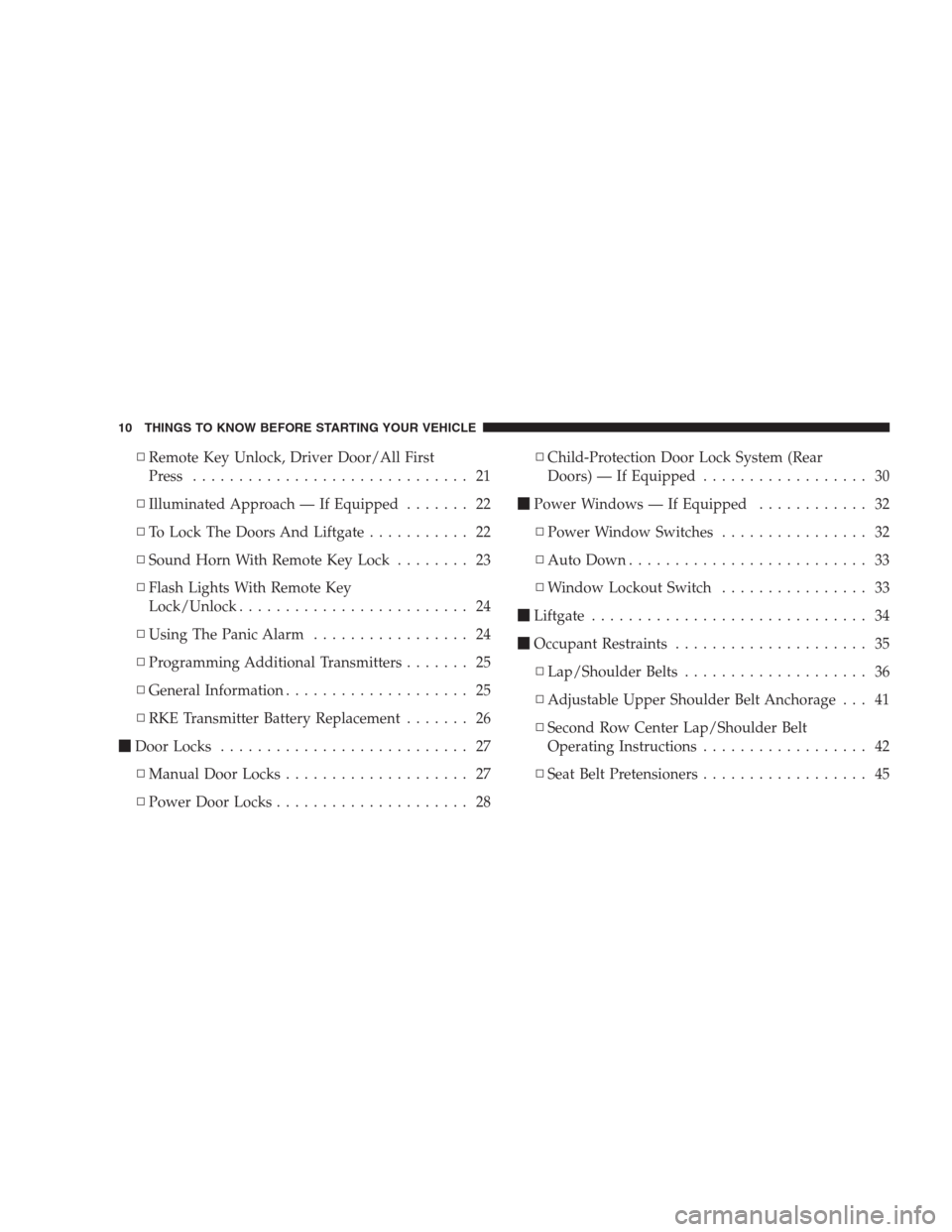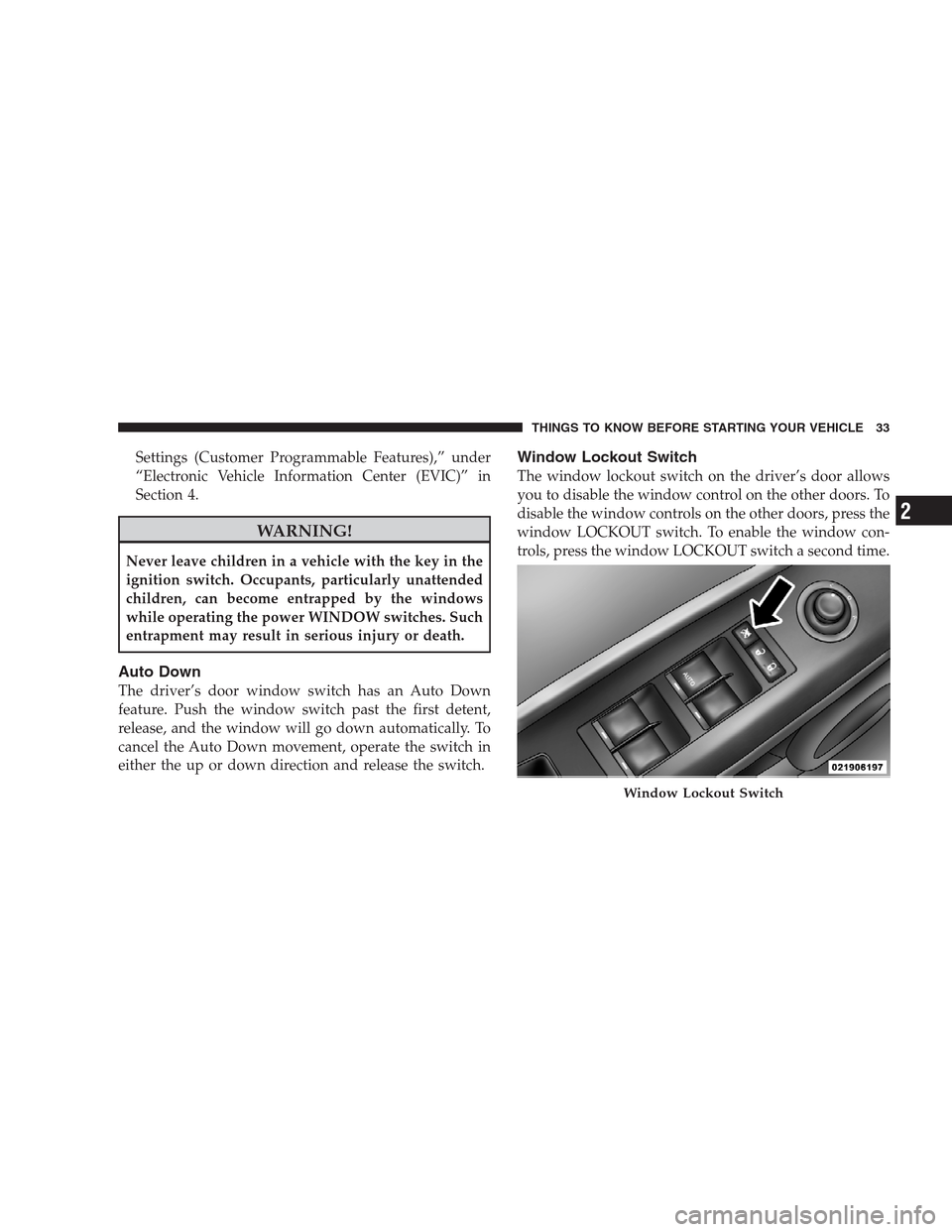Page 12 of 411

▫Remote Key Unlock, Driver Door/All First
Press .............................. 21
▫Illuminated Approach — If Equipped....... 22
▫To Lock The Doors And Liftgate........... 22
▫Sound Horn With Remote Key Lock........ 23
▫Flash Lights With Remote Key
Lock/Unlock......................... 24
▫Using The Panic Alarm................. 24
▫Programming Additional Transmitters....... 25
▫General Information.................... 25
▫RKE Transmitter Battery Replacement....... 26
�Door Locks........................... 27
▫Manual Door Locks.................... 27
▫Power Door Locks..................... 28▫Child-Protection Door Lock System (Rear
Doors) — If Equipped.................. 30
�Power Windows — If Equipped............ 32
▫Power Window Switches................ 32
▫Auto Down.......................... 33
▫Window Lockout Switch................ 33
�Liftgate.............................. 34
�Occupant Restraints..................... 35
▫Lap/Shoulder Belts.................... 36
▫Adjustable Upper Shoulder Belt Anchorage . . . 41
▫Second Row Center Lap/Shoulder Belt
Operating Instructions.................. 42
▫Seat Belt Pretensioners.................. 45
10 THINGS TO KNOW BEFORE STARTING YOUR VEHICLE
Page 15 of 411
NOTE:If you try to remove the key before you place the
shift lever in PARK, the key may become trapped tem-
porarily in the ignition switch cylinder. If this occurs,
rotate the key to the right slightly, then remove the key asdescribed. If a malfunction occurs, the system will trap
the key in the ignition cylinder to warn you that this
safety feature is inoperable. The engine can be started
and stopped but the key cannot be removed until you
obtain service.
WARNING!
Never leave children alone in a vehicle. Leaving
unattended children in a vehicle is dangerous for a
number of reasons. A child or others could be seri-
ously or fatally injured. Do not leave the keys in the
ignition. A child could operate power windows,
other controls, or move the vehicle.
Ignition Switch Positions
1 — LOCK 3 — ON
2 — ACC (ACCESSORY) 4 — STARTTHINGS TO KNOW BEFORE STARTING YOUR VEHICLE 13
2
Page 30 of 411
WARNING! (Continued)
•When leaving the vehicle, always remove the key
from the ignition lock and lock your vehicle. Do
not leave unattended children in the vehicle or
with access to an unlocked vehicle. Unsupervised
use of vehicle equipment may cause severe per-
sonal injuries and death.
CAUTION!
An unlocked vehicle is an invitation to thieves.
Always remove the key from the ignition and lock all
of the doors when leaving the vehicle unattended.
Power Door Locks
A power door lock switch is located on the drivers door
panel. Press this switch to lock or unlock the doors.
Automatic Door Locks — If Equipped
The doors will lock automatically on vehicles with power
door locks if all of the following conditions are met:
1. The Auto Lock feature is enabled.
2. The transmission is in gear.
Power Door Lock Switch Location
28 THINGS TO KNOW BEFORE STARTING YOUR VEHICLE
Page 32 of 411
4. The drivers door is opened.
5. The doors were not previously unlocked.
The Auto Unlock feature can be enabled or disabled.
Refer to “Personal Settings” under “Electronic Vehicle
Information Center (EVIC) — (if equipped)” in Section 4.
For vehicles not equipped with the EVIC, the Auto
Unlock Feature can be enabled or disabled by performing
the following procedure:
1. Close all doors and place the key in the ignition.
2. Cycle the ignition switch between LOCK and ON and
back to LOCK four times, ending up in the LOCK
position.
3. Depress the power door UNLOCK switch to unlock
the doors.
4. A single chime will indicate the completion of the
programming.NOTE:Use the Auto Door Locks and Auto Unlock
features in accordance with local laws.
Child-Protection Door Lock System (Rear Doors)
— If Equipped
Insert the tip of the ignition key into the lock and rotate
to the LOCK or UNLOCK position.
Child Protection Door Lock Location
30 THINGS TO KNOW BEFORE STARTING YOUR VEHICLE
Page 33 of 411
WARNING!
Avoid trapping anyone in a vehicle in a collision.
Remember that the rear doors can only be opened
from the outside when the child protection locks are
engaged.
NOTE:For emergency exit with the system engaged,
move the lock plunger up (unlocked position), roll down
the window and open the door with the outside door
handle.
Inserting Ignition Key
THINGS TO KNOW BEFORE STARTING YOUR VEHICLE 31
2
Page 35 of 411

Settings (Customer Programmable Features),” under
“Electronic Vehicle Information Center (EVIC)” in
Section 4.
WARNING!
Never leave children in a vehicle with the key in the
ignition switch. Occupants, particularly unattended
children, can become entrapped by the windows
while operating the power WINDOW switches. Such
entrapment may result in serious injury or death.
Auto Down
The driver’s door window switch has an Auto Down
feature. Push the window switch past the first detent,
release, and the window will go down automatically. To
cancel the Auto Down movement, operate the switch in
either the up or down direction and release the switch.
Window Lockout Switch
The window lockout switch on the driver’s door allows
you to disable the window control on the other doors. To
disable the window controls on the other doors, press the
window LOCKOUT switch. To enable the window con-
trols, press the window LOCKOUT switch a second time.
Window Lockout Switch
THINGS TO KNOW BEFORE STARTING YOUR VEHICLE 33
2
Page 66 of 411

The passenger seat belts are equipped with either
cinching latch plates or seat belt retractors that can be
switched to an automatic locking mode, which are
designed to keep the lap portion tight around the child
restraint so that it is not necessary to use a locking clip.
If the seat belt has a cinching latch plate, pulling up on
the shoulder portion of the lap/shoulder belt will
tighten the belt. The cinching latch plate will keep the
belt tight, however, any seat belt system will loosen
with time, so check the belt occasionally and pull it
tight if necessary.
If the seat belt has a switchable retractor, it will have a
distinctive label. To operate the switchable retractor,
please refer to Automatic-Locking Retractor (ALR) in this
section.
•In the rear seat, you may have trouble tightening the
lap/shoulder belt on the child restraint because the
buckle or latch plate is too close to the belt pathopening on the restraint. Disconnect the latch plate
from the buckle and twist the short buckle end of the
belt several times to shorten it. Insert the latch plate
into the buckle with the release button facing out.
•If the belt still can’t be tightened, or if by pulling and
pushing on the restraint loosens the belt, disconnect
the latch plate from the buckle, turn the latch plate
around, and insert the latch plate into the buckle
again. If you still can’t make the child restraint secure,
try a different seating position.
•Buckle the child into the seat according to the child
restraint manufacturer’s directions.
•When your child restraint is not in use, secure it in the
vehicle with the seat belt or remove it from the vehicle.
Don’t leave it loose in the vehicle. In a sudden stop or
collision, it could strike the occupants or seatbacks and
cause serious personal injury.
64 THINGS TO KNOW BEFORE STARTING YOUR VEHICLE
Page 67 of 411

Automatic-Locking Retractor (ALR)
To operate the switchable retractor, pull the belt from the
retractor until there is enough to allow it to pass through
the child restraint and slide the latch plate into the
buckle. Then pull on the belt until it is fully extended
from the retractor. Allow the belt to return into the
retractor, pulling on the excess webbing to tighten the lap
portion about the child restraint. Follow the instructions
of the child restraint manufacture.
NOTE:To reset this feature you must let all of the belt
webbing return into the retractor. You will not be able to
pull out more webbing until all of the webbing has been
returned back into the retractor.
Lower Anchors and Tether for CHildren (LATCH)
WARNING!
Child restraint anchorages are designed to withstand
only those loads imposed by correctly fitted child
restraints. Under no circumstances are they to be
used for adult seat belts, harnesses, or for attaching
other items or equipment to the vehicle.
THINGS TO KNOW BEFORE STARTING YOUR VEHICLE 65
2